chen ruo bing, "malerei"jan. 25 - mar. 8, 2003taguchi fine art, ltd. |
||
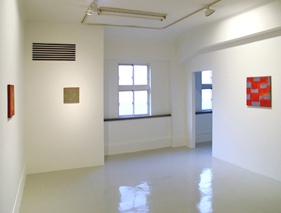
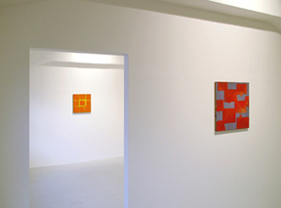
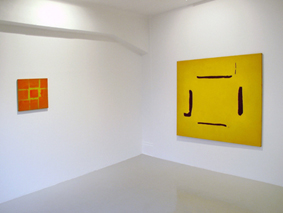
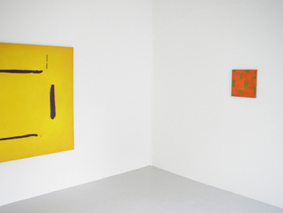
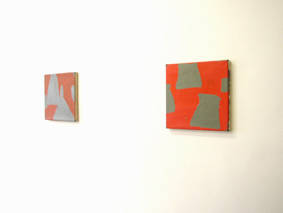
|
Born in China in 1970, Chen Ruo Bing now resides in Duesseldorf, Germany. After studying Chinese traditional landscape painting at National Academy of Fine Arts, Hangzhou in China, he moved to Germany in 1992. Since his graduation form the Art Academy in Duesseldorf in 1998, Chen has exhibited his works in France and Germany. In 2000 he invited to the United States under the artist-in-residence program at Josef and Anni Albers Foundation in Connecticut. Chinese traditional painting encounters European modernismGermany was under difficult conditions after the break down of the wall in Berlin and the integration of East and West had started, when the young Chinese painter emigrated there. General problem to be solved was the harmonization between two nations having been living under two different political systems. It was in such a transition period that Chen encountered European modern painting which developed in completely different context from Chinese painting.Ever since Chen was studying at the Art Academy in Duesseldorf, his main concern is how to unite, in his painting, the tradition of Chinese painting which is already a part of his nature, with the European modernism. Now five years has passed after his graduation from the Art Academy, his fundamental stance is the same and consistent, which is a Chinese painter who is working in the middle of European modern culture. repetition of simple formThe works he produced at the academy and shortly after his graduation were paintings, in which simple forms were repeatedly and irregularly painted on shallow, flat-colored background. These forms in fact have those origins in the forms of ordinary objects in Chinese daily life or forms which he extracts from Chinese paintings in Han Era, but the viewer cannot easily recognize what those original objects are. If anything, it might be important that those simple forms in his painting leave no traces of those origins.equal value relation between image and backgroundIn painting, whether figurative or abstract, it is common that certain forms have priority as "image" to "background". When looking paintings, we usually search for forms representing certain image, rising from the background.In case of the works by Chen, however, the painted forms are given no concrete meanings, thus do not have such priority. The painted form and the background are given equal value and stays on the same plane. As the result, the moment we distract our attention, the form recognized as image is quickly going behind and then the background is rising as the new image. Here the image and the background is indecisive and exchangeable, where we feel a sense of motion. pictorial space and decorativenessEuropean modern painters, no need to take Henri Matisse as an example, have been attracted by the shallow depth and decorativeness which are characteristic to oriental art, and enthusiastically adopted them in their works in order to reform European academic and rigid expression of space, that is, perspective. One of the effective ways to realize the decorativeness in painting is to make "image" and "background" equal. This methodology is very much familiar to Chen, who learned traditional Chinese painting.Considering only about this matter, we find that Chen's subject, the unification of Chinese painting with European modern painting would not be resolved easily. Since European modern painting has already adopted the methodology of oriental art and therefore we cannot start to treat the issue with the comprehension of their relation within the framework of simple confrontation. inner lightWe can find new development in his recent works. He has changed the material from oil to acrylic, which might be similar to Indian ink and thus easier for him to handle. And the forms in the painting are getting more abstract and geometric as square or circle, which has no origin to real objects.Also, it is characteristic to some of his paintings that we can see light overflowing from the inside of the painting to our world. Chen himself describes this as "inner light". This must indicate his interest in metaphysics. Chen Ruo Bing had one man show at Kunstverein at Lippstadt, Germany in May, 2002 and is planning to have one man show at Museum am Ostwall, Dortmund and Kulturzentrum Sinsteden, Rommerskirchen-Sinsteden in 2004. We are pleased that the show at taguchi fine art, ltd. is the first occasion to install his works in Japan. |
|
| checklist of the installation | ||
| 1. Winterrot, 1999, oil on canvas, 25 x 24 cm | ||
| 2. Intervalle, 1999, oil on canvas, 26 x 26 cm | ||
| 3. starten, 2000, oil on canvas, 22 x 21 cm | ||
| 4. untitled, 2001, acrylic on canvas, 54 x 52 cm | ||
| 5. untitled, 2002, acrylic on canvas, 30.3 x 30.4 cm | ||
| 6. untitled, 2002, acrylic on canvas, 35.1 x 35.4 cm | ||
| 7. untitled, 2001, acrylic on canvas, 35 x 35 cm | ||
| 8. untitled, 2001, acrylic on canvas, 46.2 x 44.3 cm | ||
| 9. untitled, 2001, acrylic on canvas, 140 x 150 cm | ||